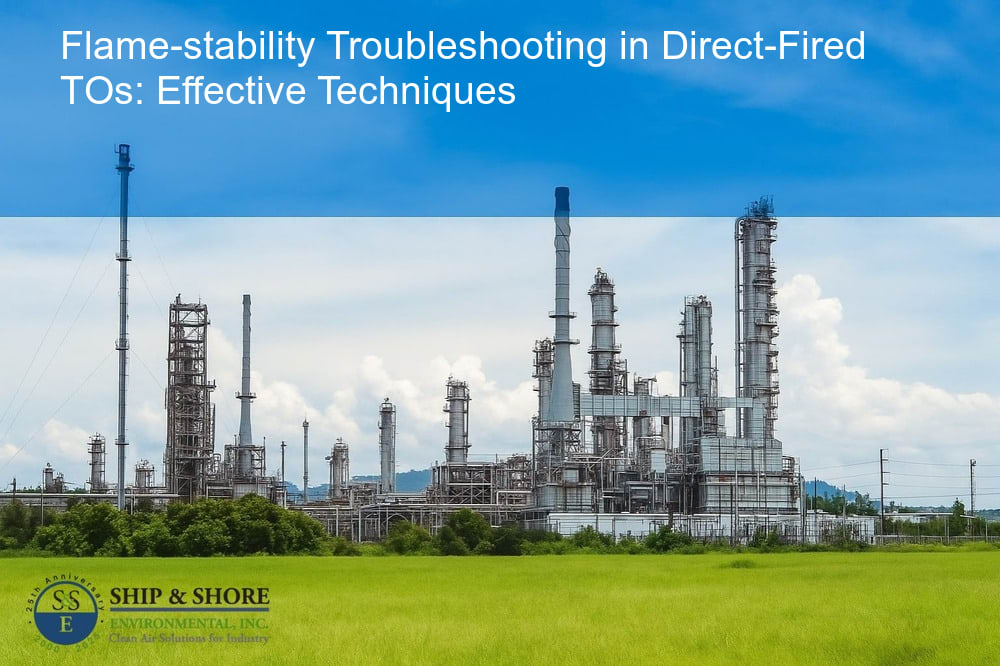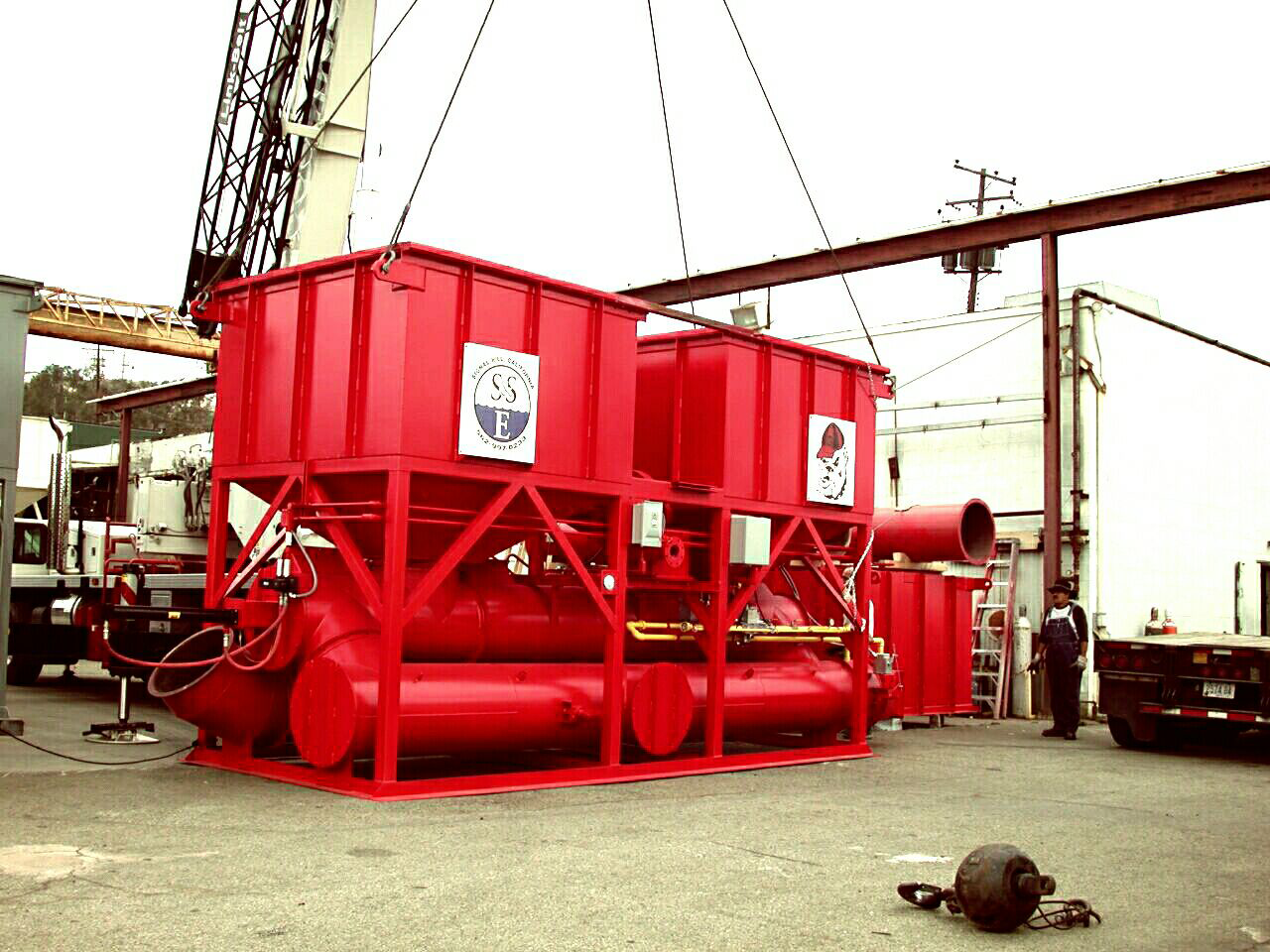
Mastering Flame-stability Troubleshooting in Direct-Fired TOs
June 18, 2025 7:20 amUnderstanding Direct-Fired Thermal Oxidizers
At Ship & Shore Environmental, Inc., we have extensive experience with direct-fired thermal oxidizers (TOs). These powerful systems are integral in the purification of industrial exhaust gases, ensuring harmful pollutants do not escape into the atmosphere. Efforts in flame-stability troubleshooting in direct-fired TOs are crucial to maintain optimal performance and to meet stringent environmental regulations.
Importance of Flame Stability in Direct-Fired TOs
Flame stability in direct-fired thermal oxidizers is critical to the efficiency and reliability of the system. A stable flame ensures complete combustion, reducing the emission of unburned hydrocarbons and other pollutants. Instability, on the other hand, can lead to incomplete combustion, increased emissions, and potential damage to the equipment. Therefore, maintaining flame stability is paramount to both operational efficiency and regulatory compliance.
Brief Overview of Flame-Stability Troubleshooting in Direct-Fired TOs
Flame-stability troubleshooting in direct-fired TOs involves identifying and addressing various issues that can affect the stability of the flame. Common problems include inconsistencies in fuel supply, fluctuations in airflow, and issues with burner components. Effective troubleshooting requires a systematic approach to diagnose and rectify these issues promptly. An understanding of the underlying causes of flame instability is necessary to implement the right solutions and ensure continuous operation of the thermal oxidizer.
Deep Dive into Flame-Stability Issues in Direct-Fired TOs
Flame stability is critical for the optimal performance of direct-fired thermal oxidizers (TOs). Without stable flames, the efficiency of emissions destruction diminishes, leading to potential compliance issues. For this reason, understanding the root causes of instability is crucial.
Several factors can contribute to flame-stability problems. Issues with the fuel-air ratio, variations in inlet VOC (Volatile Organic Compounds) concentration, and fluctuations in exhaust gas temperatures can all impact flame stability. Additionally, burner component wear and tear, as well as inadequate maintenance, often play significant roles. Immediate action is essential if you experience any of these problems, as extended instability can result in costly damage to your TO system.
Effective Strategies for Flame-Stability Troubleshooting in Direct-Fired TOs
Effective flame-stability troubleshooting in direct-fired TOs requires a systematic approach. Begin by examining the fuel supply. Any inconsistencies in fuel pressure can greatly impact the flame’s stability. Ensure that your fuel lines are clean and functioning correctly. In addition, regularly inspect the air supply system for blockages or signs of wear.
Next, confirm that the burner is in good condition. Worn or damaged burners are a frequent cause of instability. Regular maintenance routines should include thorough inspections of burner nozzles and flame sensors. Burners should be cleaned and, if necessary, recalibrated to maintain optimal performance.
Also, monitoring and adjusting the combustion settings can significantly enhance flame stability. Proper calibration of fuel-to-air ratios ensures more efficient combustion and reduces the likelihood of instability. Use advanced monitoring systems to track real-time combustion parameters. This facilitates quick adjustments whenever discrepancies arise. Besides, integrating automated control systems that adapt to fluctuating VOC levels and exhaust temperatures can offer another layer of stability.
- Conduct routine inspections of fuel supply and air systems.
- Ensure burners are clean and in good condition.
- Regularly recalibrate combustion settings.
- Implement real-time monitoring systems for immediate adjustments.
- Utilize automated controls to manage fluctuating levels.
Case Study: Successful Management of Flame Stability in Direct-Fired TOs
We had the opportunity to work with a manufacturing client experiencing persistent flame instability in their direct-fired TO. Initial diagnostics revealed inconsistent fuel pressure and worn burner components as the primary issues.
Our team began by stabilizing the fuel supply. This involved replacing outdated fuel control valves and ensuring that the fuel lines were unobstructed. Next, we focused on the burner system. We replaced the worn nozzles and recalibrated the flame sensors. Furthermore, we implemented an advanced combustion control system tailored to adapt to varying VOC concentrations and exhaust conditions.
After these changes, we observed a marked improvement in flame stability. The direct-fired TO operated more efficiently, leading to enhanced emissions control and compliance with environmental regulations. This case underscores the importance of a comprehensive approach to flame-stability troubleshooting in direct-fired TOs.
Overall, addressing flame-stability issues is not just about fixing immediate problems but also about implementing long-term solutions. By maintaining a regular inspection routine and leveraging advanced monitoring technologies, we can ensure the ongoing stability and efficiency of our direct-fired thermal oxidizers.
Did you know? Improper fuel-to-air mixtures can jeopardize flame stability in direct-fired thermal oxidizers, potentially leading to system inefficiency or shutdown.
Key Takeaways from Flame-Stability Troubleshooting in Direct-Fired TOs
As we reflect on the complexities of flame-stability troubleshooting in direct-fired TOs, a few vital lessons rise to the forefront. First and foremost, maintaining a thorough understanding of the underlying mechanisms that affect flame stability is crucial. It allows us to identify symptoms quickly and deploy effective remedies before minor issues escalate into significant problems. During our case studies, we saw that consistent and rigorous maintenance schedules play a pivotal role in sustaining optimal flame stability.
Role of Maintenance and Inspections in Ensuring Flame Stability
Regular maintenance and inspections form the backbone of flame-stability management in direct-fired TOs. By adhering to stringent schedules for equipment checks, cleaning, and parts replacement, we can preemptively address potential disruptions. For example, the cleaning of fuel nozzles and the recalibration of burner controls can significantly reduce the likelihood of unstable flames. Continual monitoring and documentation also help us establish a baseline of normal operation, making it easier to pinpoint anomalies when they arise.
The Future: Innovations in Flame-Stability for Direct-Fired TOs
Looking forward, the future of flame stability in direct-fired TOs is promising, thanks to ongoing technological advancements. Innovations in sensor technology and automation are poised to revolutionize how we approach flame-stability troubleshooting in direct-fired TOs. Real-time data analytics and AI-driven predictive maintenance can offer unprecedented precision and efficiency in identifying and mitigating issues. These advancements can lead to increased operational uptime and reduced maintenance costs, further enhancing the overall reliability of direct-fired thermal oxidizers.
FAQ
What are direct-fired thermal oxidizers (TOs) and why is flame stability important?
Direct-fired thermal oxidizers are industrial equipment used to destroy volatile organic compounds (VOCs) by combusting them at high temperatures. Stable flames are essential for ensuring effective operation because they enable consistent and efficient VOC destruction while minimizing the production of harmful byproducts. Likewise, consistent flame stability is crucial to the longevity of the equipment and safety of the operation.
What are some common causes of flame instability in direct-fired TOs?
Flame instability in direct-fired TOs can be caused by various factors, such as improper fuel-to-air mixtures, nozzle clogs, worn out components, and control system malfunctions. Consequently, diagnosing these issues early on, through vigilant monitoring and regular inspections, is imperative for maintaining stable flames and optimal TO performance.
How do regular maintenance and inspections contribute to flame stability?
Regular maintenance and inspections are vital in preserving flame stability as they enable early detection of any irregularities or wear in system components. During these inspections, parts like fuel nozzles are cleaned and burner controls may be recalibrated. As a result, this attention to detail helps mitigate risks of instability and ensures the smooth functioning of the TO.
Can you describe effective strategies for troubleshooting flame-stability issues in direct-fired TOs?
Effective strategies for troubleshooting flame-stability issues include performing a comprehensive analysis of the combustion process to identify potential disruptions, checking fuel quality and consistency, examining the burner for mechanical defects, and ensuring proper calibration of control systems. Furthermore, incorporating advanced sensor technology can streamline this process by providing real-time feedback for quicker adjustments and stability management.
What innovative approaches are being developed to enhance flame stability in direct-fired TOs?
Innovation in flame stability for direct-fired TOs is progressing rapidly with the integration of advanced sensor technology, improved combustion control systems, and AI-driven predictive maintenance tools. These advancements are paving the way for a new era of operational efficiency. Notably, real-time analytics and machine learning algorithms offer enhanced monitoring capabilities, leading to proactive rather than reactive maintenance strategies, which in turn, safeguard the stability of the flame and overall system health.
Categorised in: Blog

